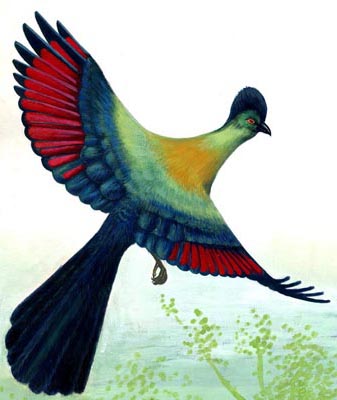The ENTC now has a new website, at www.entc.org.sz
Our logo is adapted from a painting by Phillip Dlamini, 1998, of a purple crested turaco. In traditional Swazi dress, the red feathers feature in the royal headdress, so this bird illustration is not only a symbol for wildlife conservation, but also of cultural heritage.


Last update by Bob Forrester, December 2005.
The iron rich area known as Bomvu Ridge was first explored in 1946 when the Geological Mines and Survey department started prospecting the Ngwenya iron deposits. The Bomvu deposit had been recorded on a map of the Swaziland Corporation in 1889 but had been forgotten for over 50 years. By 1957 prospecting operations had identified reserves of ore in excess of 30,000,000 tons with a mean value of 60% metallic iron content.
The holder of the mineral concession, the Anglo American Corporation of South Africa, decided to develop the ore body in 1958 and formed the Swaziland Iron Ore Development Corporation. It started production in 1964. By 1977 the richer ores had all been extracted and by 1979 about 28 000 000 tons of high grade haematite had been removed. The mine closed in 1980 and the land was donated to the SNTC.
During the modern mining period much archaeological evidence was swept away, but the SIODC should be given credit for sacrificing a million or more tons of ore underlying the ancient mine at Lion Cavern.
Iron ore mining was responsible for starting the modern industrial phase in the country. The location of the iron on the western border, with the export outlet on the eastern border, led to the creation of a road and rail infrastructure across the country. This helped Swaziland's sugar industry to export their product to Maputo at low cost. The railway line ran through Matsapha, an area zoned for industrial use. The first company to open was a brewery, the second manufactured cardboard boxes to put the beer in. The Swaziland Electricity Board was formed to provide power to the mine and the country as a whole.
The mine was responsible for a great deal of international cooperation. To get the ore to Maputo two railway lines were built, one in Swaziland to the border (218 km) and one from the border to the railhead at Goba in Mozambique. The market for the ore was Japan, and to get it there it was shipped in three large 77 500 ton ore carrying ships built in Norway. To accommodate these ships a new dock was built in Maputo and the harbour channel was deepened.
Our Contacts:
Head Quarters: (+268) 2416 1489/1179
Email: info@sntc.org.sz
King Sobhuza II Park: (+268) 2416 1489/1179
Email: ksmp@sntc.org.sz
National Museum: (+268) 2416 1489/1179
Email: curator@sntc.org.sz
Copyright © ESWATINI NATIONAL TRUST COMMISSION
Malolotja Nature Reserve: (+268) 2444 3241 / (+268) 2416 1480
Email: culturalvillage@sntc.org.sz
Mantenga Nature Reserve and Swati Cultural Village: 2416 1151/1178
Email: culturalvillage@sntc.org.sz
Mlawula Nature Reserve: (+268) 2383 8885 (Reception)
(+268) 2383 8453 (Senior Warden)
Email: culturalvillage@sntc.org.sz
Magadzavane Lodge: (+268) 2343 5108/9
Email: magadzavane@sntc.org.sz